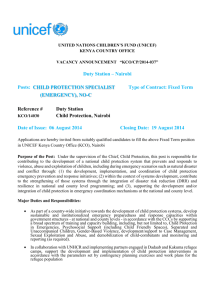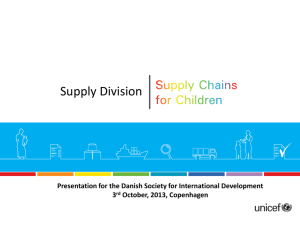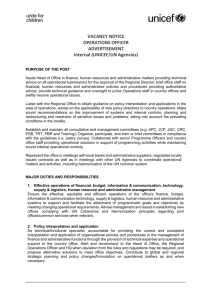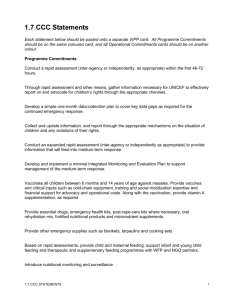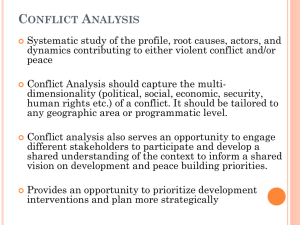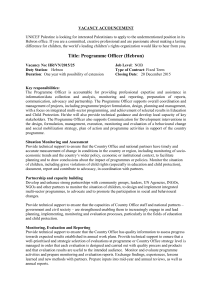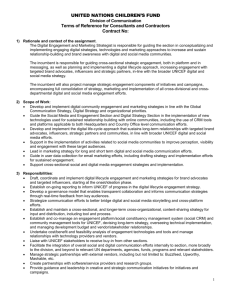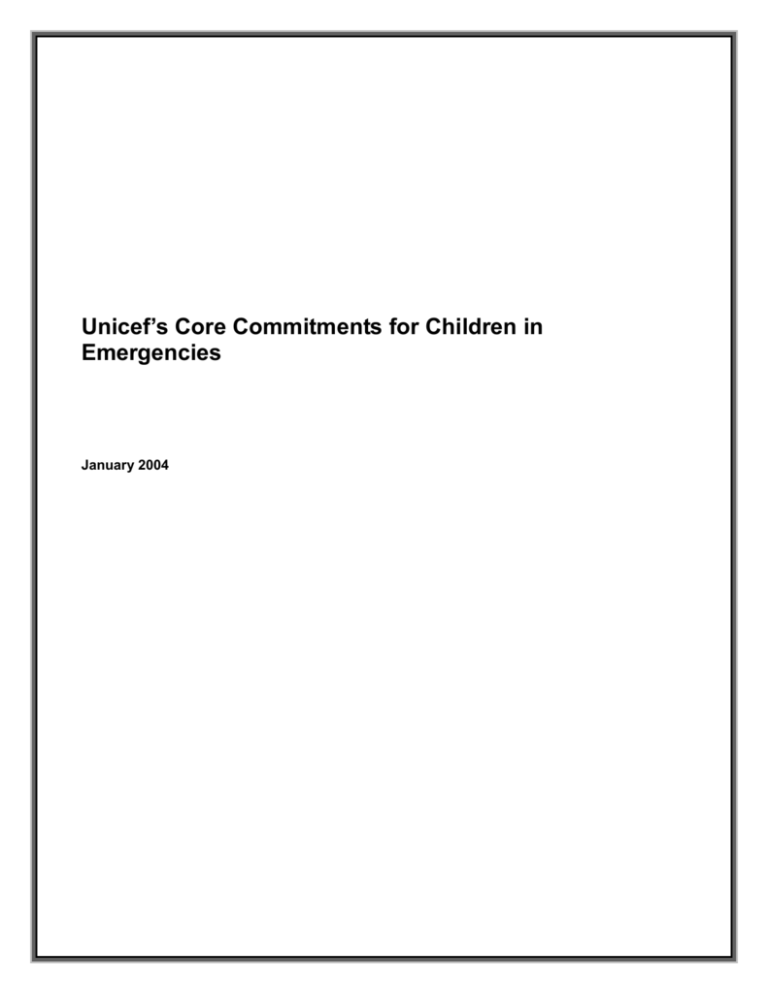
Unicef’s Core Commitments for Children in
Emergencies
January 2004
Table of Contents
Introduction ......................................................................................................................................................3
Guiding Principles ...........................................................................................................................................3
Operating Approach .........................................................................................................................................3
Programme CCCs ............................................................................................................................................4
Operational CCCs ............................................................................................................................................5
Functions ..........................................................................................................................................................6
Financial Resource Allocation .........................................................................................................................8
Annex 1: Principles and Core Commitments ...................................................................................................9
Programme Core Commitments ................................................................................................................13
First Six to Eight Weeks of a Crisis ......................................................................................................13
Operational Core Commitments ................................................................................................................20
1.3 UNICEF’S CORE COMMITMENTS FOR CHILDREN IN EMERGENCIES
Introduction
The purpose is to outline UNICEF emergency
response, distinguishing between the full spectrum of activities that UNICEF may undertake, in
collaboration with national, UN and NGO partners, in the course of an emergency and those
commitments that UNICEF will deliver in the first six to eight weeks of any crisis situation, through
the following:
clarifying key guiding principles and operating approaches;
defining the initial response commitment that UNICEF, in collaboration with partners, will
meet in the first six to eight weeks of a crisis;
further refining the core response that UNICEF may undertake in collaboration with partners in
the course of an emergency, and
defining the operational readiness UNICEF will undertake to allow for a timely response.
Guiding Principles
a) Children in the midst of armed conflict and natural disasters such as drought, floods, and
earthquakes have the same needs and rights as children in stable countries.
b) Our response will recognize the priority of humanitarian action while assuring safe access
to affected populations, and safety and security of staff and assets.
c) The emergency response will build on existing activities and partnerships developed
through the country programme of cooperation.
d) The response will be based on nationally defined priorities and UNICEF’s comparative
advantage.
Operating Approach
a) Conduct a rapid assessment to identify priority humanitarian action for children.
b) Implement a valid and reliable system to monitor, regularly report on and publicise the
needs of children and to evaluate the impact of the response.
c) Establish UNICEF’s response as part of a coordinated UN response plan, designed in
collaboration with national and other partners.
d) Position UNICEF in sector coordinating roles, wherever appropriate.
e) Put in place operational systems and resources in place for rapid delivery of supplies and
technical assistance.
f)
Operationalize humanitarian response mechanisms that prevent and limit the exposure of
children and women to abuse, violence, exploitation and HIV/AIDS
1.3 UNICEF’S CORE COMMITMENTS FOR CHILDREN IN EMERGENCIES
Programme CCCs
UNICEF will respond throughout the phases of an
emergency. In the first six – eight weeks of a crisis there are six priority areas for UNICEF
intervention. Once this initial emergency response is well established, other activities may be
introduced.
In the first six to eight weeks following the outbreak of a crisis, UNICEF will work with partners
to meet the following commitments:
1. Within established mechanisms, assess, monitor, advocate for, report and
communicate on the situation of children and women: conduct a rapid assessment of
the situation of children and women, establish initial monitoring systems, including on
severe or systematic abuse, violence or exploitation, and report through the appropriate
mechanisms.
2. Provide measles vaccination, vitamin A, essential drugs and nutritional
supplements: vaccinate children between 6 months and 14 years of age against
measles, at a minimum children from 6 months to 4 years of age must be immunized, and
provide vitamin A supplementation as required. Provide essential drugs, basic and
emergency health kits, oral rehydration mix, fortified nutritional products and micronutrient
supplements. Provide post-rape-care kits, including post-exposure prophylaxis for HIV,
where appropriate, to health posts. Provide other emergency supplies such as blankets,
tarpaulins, etc.
3. Provide child and maternal feeding and nutritional monitoring: support infant and
young child feeding, therapeutic and supplementary feeding programmes with WFP and
NGO partners. Introduce nutritional monitoring and surveillance.
4. Provide safe drinking water, sanitation and hygiene: emergency water supply and
purification, provision of basic family water kits, safe disposal of faeces and hygiene
education.
5. Assist in the prevention of separation and facilitate the identification, registration and
medical screening of children separated from their families, ensure family tracing
systems are put in place and provide care and protection, and prevent sexual abuse
and exploitation of children and women.
6. Initiate the resumption of schooling and other child learning opportunities: set-up
temporary learning spaces and re-open schools and start re-integrating teachers and
children, with a focus on girls, and organize recreational activities.
To fulfil these initial emergency response commitments, UNICEF will cooperate with national
governmental and non-governmental bodies and other international partners, with an emphasis on
community capacity building from the onset.
Beyond the initial response, country offices may address other elements of the core
commitments to children in emergency situations. It is particularly important as the situation evolves
that UNICEF consider the transition to national ownership and leadership and support the building of
national systems.
Monitoring and Advocating on the Situation of Children: a) ensure that information on the
situation of children and violations of their rights is collected and updated; b) make available this
information to relevant partners, child rights advocates, the public and media, as appropriate; c) be
prepared to use UNICEF’s voice on behalf of children.
Survival: a) expand support to vaccination and preventive health services (provide essential health
supplies and services to prevent mortality amongst children and pregnant and lactating women
related to diarrhoea, pneumonia and malaria, including emergency obstetric care services); b)
support infant and young child feeding, including breastfeeding and complementary feeding and,
1.3 UNICEF’S CORE COMMITMENTS FOR CHILDREN IN EMERGENCIES
when necessary, support therapeutic and supplementary feeding programmes; c) establish,
improve and expand safe water and sanitation facilities and promote safe hygiene behaviour.
Organizing Child Protection: a) Continue support to identify and register unaccompanied and
orphaned children, and support communities to provide for their protection and care; b) establish
child friendly spaces for children and women and provide psychosocial support; c) monitor, report on
and advocate against abuse and exploitation of children including recruitment of child soldiers and
other exploitative forms of child labour; d) initiate work on the release and reintegration of child
combatants; e) promote activities that prevent and respond to sexual violence against children and
women; f) lead in organization of mine risk education.
Resuming primary education services: Re-establish and/or sustain primary education as well as
establishing community services within schools (such as water supply and sanitation).
Preventing HIV/AIDS: a) provide access to relevant information on HIV/AIDS; b) in collaboration
with relevant partners facilitate young people’s access to comprehensive HIV prevention services
including treatment for sexually transmitted infections.
Operational CCCs
Operational commitments have been developed in the areas of communication and fund raising,
security and operations (human resources, information technology, finance and administration and
supply and logistics) to provide the appropriate systems support for meeting the programme
commitments.
In the first six to eight weeks, UNICEF will have the following resources and capacity in support of
timely programmatic interventions:
1. Address humanitarian needs while assuring the safe access to affected populations, and
the safety and security of staff and assets.
2. Communicate on the situation and needs of children. Within the inter-agency framework,
fundraise for UNICEF programmes.
3. Identify and deploy experienced staff through internal deployment, external recruitment,
and standby arrangements with partners.
4. Provide telecommunications services required for program implementation, in compliance
with the Minimum Operating Security Standards (MOSS).
5. Mobilize emergency supplies within 24 to 48 hrs, assist in the development of a country
plan and put in place procedures and directives for continued delivery of supply components
including inter-country transfer and movement of supplies.
6. Assess financial and administrative capacity in country, and institute methods of fund
disbursements and accounting and security of assets, while preserving safety of staff
members, partners and assets.
Enclosed as annex 1 is a detailed outline of the guiding principles, operating approaches,
programme and operational CCCs.
1.3 UNICEF’S CORE COMMITMENTS FOR CHILDREN IN EMERGENCIES
Functions
To fulfil these core commitments, different parts of the organization are to undertake the following
key activities from the onset of an emergency or in preparation for one:
Country Office
1. Regularly update contingency and preparedness plans on the basis of sound early warning
analysis.
2. Achieve compliance with MOSS requirements.
3. Conduct rapid assessments (inter-agency or independently as appropriate) to ensure that the
CO can plan its response as well as report on the situation of children and women.
4. Implement the Initial Emergency Response Commitments.
5. Within 24 hours prepare supply plan and share with RO and HQ-SD for their immediate
action.
6. Ensure IT and telecommunications services for programme implementation and in
compliance with MOSS.
7. Prepare human resource plan and approach RO and HQs for deployment of additional staff
as required.
8. Identify financial resource requirements and utilize the options available within the
organization to immediately allocate financial resources.
9. Within 24 – 72 hours prepare a brief “pitch document” on issues, action, and impact (without
budget) for sharing with government and Natcom donors.
10. Within 1 – 2 weeks release an indicative Plan of Action with budget for sharing with
government and Natcom donors.
11. Within 1 month, prepare an emergency appeal in coordination with PFO and other UN
agencies and be ready to provide proposals geared to specific donors as required.
12. Communicate on the situation and needs of children through local and international media
within the first 72 hours, as appropriate.
13. Timely monitoring and evaluation.
14. Ensure identification of learning needs for emergencies, development of learning plans and
access for relevant staff to core learning opportunities.
Regional Office
1. Monitor COs continued early warning analysis, provide additional regional level early warning
analysis, and provide a “back-up” trigger for CO action on analysis where necessary.
2. With the CO identify the specific areas where support is required in the areas of human,
financial and supply/logistics resources, with clear TORs outlined for human resource
deployment within 24 hours.
3. Make RO staff available within 48 hrs.
4. On the basis of the CO HR plan, work with HQs to identify staff, including initiating contact
with neighbouring offices for additional staff support.
5. Provide IT and telecommunications technical assistance.
6. Prepare regional supply standby arrangements and/or stockpiles of critical inputs for rapid
deployment.
7. Provide programme oversight, guidance and support.
8. Approve the appeal and funding requests put forward by the CO, in consultation with HQs.
9. Advocate in coordination with the CO and HQs, and report to the international community
issues and developments including funding needs.
10. Provide stress management and counselling support to staff through regional mechanisms,
as needed.
1.3 UNICEF’S CORE COMMITMENTS FOR CHILDREN IN EMERGENCIES
11. Support Country offices in the identification of learning needs, development of learning plans
and provide learning opportunities.
Headquarters
1. Trigger and identify situations to be treated as priority emergencies on the basis of early
warning analysis.
2. In the event that CO resources are insufficient, identify options for providing additional
financial resources within 24 hrs of the ED or her Deputy request to do so.
3. In consultation with Country and Regional office, expedite interim deployment of staff,
including through identifying staff from other locations for immediate deployment, and global
standby agreements with partners.
4. Designate “Crisis Manager” at HQs as the primary focal point for communication with the CO
and RO on the emergency response.
5. Prepare global supply standby arrangements and/or stockpiles for critical inputs so they are
available for rapid deployment.
6. Provide IT and telecommunications strategy, standards, and technical architecture in close
consultation with Regional and Country office.
7. Liaise and coordinate with other UN agencies involved in the emergency response,
particularly OCHA, UNJLC and UNSECOORD on policy, security, logistics and resource
mobilization.
8. Provide security tracking and backstopping.
9. Provide programme guidance and support, and approve appeal in consultation with RO.
10. Initiate contact with the international media and donors within 72 hours in collaboration with
the respective CO and RO.
11. Provide policy support, develop learning strategies and materials, organize global workshops
(TOTs) and provide guidance on emergency learning.
1.3 UNICEF’S CORE COMMITMENTS FOR CHILDREN IN EMERGENCIES
Resources must be available to allow the
organization to meet these core commitments,
particularly in the first six to eight weeks of a crisis.
Donor resources appealed for through an inter-agency or stand-alone appeal are in almost all cases
not available in the first few days of the emergency. Country representatives must therefore
exercise judgement to realign country resources and seek additional resources to address these
Initial Emergency Response commitments. The following options are available in the order
presented:
Financial Resource Allocation
1. Reprogramming Country Funds
1.1 The authorization level of Representatives for reprogramming of RR funds for emergencies
should be increased as follows:
CP RR Allotment
$2 million or more
less
than
$2
million
Current level
$100,000
$75,000
Proposed level
$200,000
$150,000
1.2 As authorized by the respective donor and cleared by PFO, the Country Office may reprogramme OR funds.
2. Utilize EPF for upfront funding of emergency response. The EPF is a loan mechanism and as
resources are mobilized the CO is required to reimburse the funds through subsequent donor
contributions for the emergency response.
EMOPS in consultation with the DED and relevant sections will initiate discussions to explore the
possibility of increasing the EPF ceiling in the coming biennium and establishing clear criteria for
loan eligibility and reimbursement.
3. Utilize higher than planned RR (i.e. RR for unfunded OR), to be allocated by the Executive
Director, for emergency response. Note that current regulations only allow for CO that have a
CAP or OR unfunded ceiling for at least 12 months to benefit from this. A management and
monitoring system will be established by PD to ensure effective and efficient allocation of the
funds, and to coordinate reporting requirements and mechanisms with the CO and RO.
4. Country Offices that are prone to a crisis should keep on reserve up to 30 September (?) 5 – 10
per cent of their RR allocation for re-programming in response to a crisis.
5. Utilize 7 per cent set-aside at the discretion of the Executive Director.
Additional ways of mobilizing resources
In the last few years, UNICEF has borrowed funds from the UN-OCHA managed Central Emergency
Revolving Fund (CERF) for immediate response. As donor funds come in, the loan is reimbursed
within 6-12 months. UNICEF will continue to utilise CERF loans as appropriate.
As approved by the RO and subject to the availability of funds, COs may utilize resources from the 5
per cent Regional Contingency Budget for administrative support requirements.
1.3 UNICEF’S CORE COMMITMENTS FOR CHILDREN IN EMERGENCIES
Annex 1: Principles and Core Commitments
Guiding Principles
Key guiding principles UNICEF will follow throughout an emergency response.
1. Children in the midst of armed conflict and natural disasters such as drought, floods, and earthquakes have the same needs
and rights as children in stable countries.
2. Our response will recognize the priority of humanitarian action while assuring safe access to affected populations, and safety
and security of staff and assets.
3.
The emergency response will build on existing activities and partnerships developed through the country programme of
cooperation.
4.
The response will be based on nationally defined priorities and UNICEF’s comparative advantage.
1.3 UNICEF’S CORE COMMITMENTS FOR CHILDREN IN EMERGENCIES
9
Operating Approach
Operating approach UNICEF will apply throughout an emergency response.
1. Conduct a rapid assessment to identify priority humanitarian action for children.
2. Implement a valid and reliable system to monitor, regularly report on and publicize the needs of children and to evaluate the
impact of the response.
3. Establish UNICEF’s response as part of a coordinated UN response plan, designed in collaboration with national and other
partners.
4. Position UNICEF in sector coordinating roles, wherever appropriate.
5. Put in place operational systems and resources for rapid delivery of supplies and technical assistance.
6. Operationalize humanitarian response mechanisms that prevent and limit the exposure of children and women to abuse,
violence, exploitation and HIV/AIDS.
1.3 UNICEF’S CORE COMMITMENTS FOR CHILDREN IN EMERGENCIES
10
Rapid Assessment
In consultation and collaboration with partners, UNICEF will carry out a rapid assessment of the situation of children and women. Drawing
upon data compiled in the preparedness phase, this situation analysis will determine the exact nature of the crisis, including potential
developments, implications for the rights of children and women, and the required programmatic response, operational modalities and
security.
First six to eight weeks
1. Immediately conduct a rapid assessment (inter-agency or independently, as appropriate) within the first 48-72 hours to determine:
programmatic needs in health and nutrition, education, child protection, water supply and sanitation, HIV/AIDS and other
salient child rights issues
factors affecting the organization’s capacity to function in the field: e.g. the presence of national telecommunications and
infrastructure, access and mobility, and the availability/readiness of office infrastructure, vehicles, warehousing and human
resources for UNICEF and/or agencies working in the area.
This requires compiling basic data required through secondary research, new data collection from immediate site visits, and analysis
and extrapolation from data previously compiled in the preparedness phase. This first rapid assessment will provide the basis for the
UNICEF’s programmatic response.
2. Through rapid assessment and other means, gather information necessary for UNICEF to effectively report on and advocate for
children’s rights through the appropriate channels.
3. Within the first week, develop a simple one-month data-collection plan to cover key data gaps as required for the continued
emergency response. This brief plan will identify: data gaps regarding children’s and women’s rights; key questions to be monitored
regarding the immediate implementation of the programme response (areas where bottlenecks may occur, activities about which
managers are most concerned); an outline of focused assessments or field visits to cover these data needs; and resources
assigned to cover data-collection activities. Ideally the plan should also reflect key data collection activities by other organizations
that might contribute to the plan’s overall effectiveness.
4. Collect and update information, and report through the appropriate mechanisms on the situation of children and any violations of
their rights.1
1
Reference should be made to the Core Commitments for Child Protection
1.3 UNICEF’S CORE COMMITMENTS FOR CHILDREN IN EMERGENCIES
11
Beyond initial response
5. Conduct an expanded rapid assessment (inter-agency or independently as appropriate) to provide information that will feed into
medium-term response, e.g. a 100-day plan. This will also draw from secondary data from other organisations and will either be a
synthesis/analysis exercise, if field data collection has continued through the first three weeks, or will require a second intensive
field data-collection exercise.
6. Develop and implement a minimal Integrated Monitoring and Evaluation Plan to support management of the medium-term response
with key indicators on implementation and output (e.g. inputs delivered; coverage of therapeutic feeding) and where possible
outcome indicators (e.g. on nutrition status), and the information systems to be used (e.g. reporting by partner NGOs, field visits).
Identify additional data requirements and collection mechanisms.
Coordination
Ensure that UNICEF’s response is part of a coordinated UN response, designed in collaboration with local and other partners;
Assume a sector coordinating role as appropriate.
1. In partnership with UN agencies, national authorities and others, ensure capacity where needed to assume a coordinating
role for:
Public Health
Nutrition
Child Protection
Education
Water, Sanitation and Hygiene
2. Support the Resident Coordinator/Humanitarian Coordinator (RC/HC) structure in ensuring a clear coordination mechanism is
formed as quickly as possible, including possibilities for creating common systems.
3. Identify partners for interventions in the areas of health, nutrition, education, child protection and water and sanitation with a
clear division of labour.
1.3 UNICEF’S CORE COMMITMENTS FOR CHILDREN IN EMERGENCIES
12
Programme Core Commitments
First Six to Eight Weeks of a Crisis: Initial Emergency Response Commitments
Initial emergency response commitments that UNICEF, in collaboration with partners, will address in the first six to eight weeks of an
emergency. To realize these commitments, UNICEF will commit resources and cooperate with national bodies and other partners,
with emphasis on building local capacity from the outset.
1. Within established mechanisms, assess, monitor, advocate for, report and communicate on the situation of children and
women: (i) conduct a rapid assessment of the situation of children and women; (ii) establish initial monitoring systems,
including on severe or systematic abuse, violence or exploitation, and report through the appropriate mechanisms.
2. Health: (i) vaccinate all children between 6 months and 14 years of age against measles, at minimum children from 6 months
through 4 years of age must be immunized. Provide vaccines and critical inputs such as cold-chain equipment, training and
social mobilization expertise, financial support for advocacy and operational costs. Along with the vaccination, provide vitamin
A supplementation as required; (ii) provide essential drugs, emergency health kits, oral rehydration mix, fortified nutritional
products and micronutrient supplements; (iii) provide other emergency supplies such as blankets, tarpaulins, etc.
3. Nutrition: (i) based on rapid assessments, provide child and maternal feeding: support infant and young child feeding and
therapeutic and supplementary feeding programmes with World Food Programme and NGO partners; (ii) introduce nutritional
monitoring and surveillance.
4. Water, Sanitation and Hygiene: (i) ensure the availability of a minimum safe drinking water supply taking into account the
privacy, dignity and security of women and girls; (ii) provide bleach, chlorine or water purification tablets, including detailed
user and safety instructions; (iii) provide jerry cans, or an appropriate alternative, and include user instructions and messages
on the handling of water and disposal of excreta and solid waste; (iv) provide soap and disseminate key hygiene messages
on the dangers of cholera and other water- and excreta-related diseases; (v) facilitate safe excreta and solid waste disposal
by providing equipment, support for education and operational costs.
5. Child Protection: (i) conduct a rapid assessment of the situation of children and women. Within the appropriate mechanisms,
monitor, advocate against, report and communicate on severe, systematic abuse, violence and exploitation; (ii) assist in the
prevention of separation, and facilitate the identification, registration and medical screening of separated children, particularly
those under five years of age and adolescent girls; (iii) ensure that family-tracing systems are put in place with appropriate
1.3 UNICEF’S CORE COMMITMENTS FOR CHILDREN IN EMERGENCIES
13
care and protection facilities; (iv) prevent sexual abuse and exploitation of children and women by monitoring, reporting and
advocating against instances of sexual violence, providing post-rape health and psychosocial care and support. Internally,
with regards to humanitarian workers and staff, undertake and promote humanitarian activities in a manner that minimizes
opportunities for sexual exploitation and abuse. Ensure that all UNICEF staff and partners sign the Code of Conduct and be
aware of appropriate mechanisms for reporting breaches of any of its six core principles.
6. Education: (i) set-up temporary learning spaces with minimal infrastructure; (ii) resume schooling by re-opening schools and
starting the reintegration of teachers and children by providing teaching and learning materials, and organizing semistructured recreational activities.
7. HIV/AIDS: provide post-rape-care kits, including post-exposure prophylaxis for HIV, where appropriate, to health posts.
Health and Nutrition
To promote access to essential and quality health and nutritional services, in collaboration with partners, UNICEF will:
First six to eight weeks
1. Vaccinate all children between 6 months and 14 years of age against measles, at minimum children from 6 months through 4
years of age must be immunized. Provide vaccines and critical inputs such as cold-chain equipment, training and social
mobilization expertise and financial support for advocacy and operational costs. Along with the vaccination, provide vitamin A
supplementation, as required.
2. Provide essential drugs, emergency health kits, post-rape-care kits where necessary, oral rehydration mix, fortified nutritional
products and micronutrient supplements.
3. Provide other emergency supplies such as blankets, tarpaulins and cooking sets.
4. Based on rapid assessments, provide child and maternal feeding: support infant and young child feeding and therapeutic and
supplementary feeding programmes with World Food Programme and NGO partners.
5. Introduce nutritional monitoring and surveillance.
Beyond initial response
1.3 UNICEF’S CORE COMMITMENTS FOR CHILDREN IN EMERGENCIES
14
6. Support the establishment of essential health-care services, including by providing outreach services and home-based
management of childhood illnesses and emergency obstetric care services, including commodities for malaria, diarrhoea and
pneumonia.
7. Provide tetanus toxoid with auto-disable syringes and other critical inputs such as cold-chain equipment, training and
behavioral change expertise, and financial support for advocacy and operational costs for immunization of pregnant and
childbearing age women.
8. Support infant and young child feeding, complementary feeding, and when necessary support therapeutic and supplementary
feeding programmes with World Food Programme and NGO partners.
9. Provide health and nutrition education, including messages on the importance of breastfeeding and safe motherhood
practices.
1.3 UNICEF’S CORE COMMITMENTS FOR CHILDREN IN EMERGENCIES
15
Water, Sanitation and Hygiene
To ensure the provision of safe water and proper sanitation for children and women, in collaboration with partners, UNICEF will:
First six to eight weeks
1. Ensure the availability of a minimum safe drinking water supply taking into account the privacy, dignity and security of women and girls.
2. Provide bleach, chlorine or water purification tablets, including detailed user and safety instructions in the local language.
3. Provide jerry cans, or an appropriate alternative, including user instructions and messages in the local language on handling of water and
disposal of excreta and solid waste.
4. Provide soap and disseminate key hygiene messages on the dangers of cholera and other water- and excreta-related diseases.
5. Facilitate safe excreta and solid waste disposal by providing shovels, cash for contracting local service companies to dispose of solid
waste; messages on the importance of keeping excreta (including infant faeces) buried and away from habitations and public areas;
messages on disposal of human and animal corpses; instructions on, and support for construction of trench and pit latrines.
Beyond initial response
6.
Make approaches and technologies used consistent with national standards, thus reinforcing long-term sustainability.
7. Define UNICEF’s continuing involvement beyond the initial response, by:
Establishing, improving and expanding safe water systems for source development, distribution, purification, storage and drainage
taking into account evolving needs, changing health risks and greater demand
Providing a safe water supply, sanitation and hand-washing facilities at schools and health posts
Supplying and upgrading sanitation facilities to include semi-permanent structures and household solutions, and providing basic
family sanitation kits
Establishing regular hygiene promotion activities
Planning for long-term solid waste disposal
1.3 UNICEF’S CORE COMMITMENTS FOR CHILDREN IN EMERGENCIES
16
Child Protection
UNICEF commits to the protection of children and women from violence, exploitation, abuse and neglect, and in collaboration with
partners will:
First six to eight weeks
1. Conduct a rapid assessment of the situation of children and women. Within the appropriate mechanisms, monitor, advocate
against, report and communicate on severe, systematic abuse, violence and exploitation.
2. Assist in the prevention of separation, and facilitate the identification, registration and medical screening of separated children,
particularly those under 5 years of age and adolescent girls.
3. Ensure that family-tracing systems are implemented with appropriate care and protection facilities.
4. Prevent sexual abuse and exploitation of children and women by: (i) monitoring, reporting and advocating against instances of
sexual violence by military forces, state actors, armed groups and others (ii) provide post-rape health and psychosocial care
and support.2 Internally, with regards to humanitarian workers and staff: (i) undertake and promote humanitarian activities in a
manner that minimizes opportunities for sexual exploitation and abuse (ii) have all UNICEF staff and partners sign the Code of
Conduct and are aware of appropriate mechanisms for reporting breaches of its six core principles.
Beyond initial response
5. Within established mechanisms, support the establishment of initial monitoring systems, including on severe or systematic
abuse, violence and exploitation.
6. In cases where children are separated from caregivers, or at risk of being separated, directly and through partners expand
support to: (i) assist in preventing the separation of children from their caregivers (ii) facilitate the identification, registration and
medical screening of separated children, particularly those under five and adolescent girls (iii) facilitate the registration of all
parents/caregivers who have lost their children (iv) provide support for the care and protection of separated children, including
shelter (v) support partners involved in tracing and reunification, and provide tracing equipment, as required.
7. Provide support for the care and protection of orphans and other vulnerable children.
2
Reference should be made to the Core Commitments for HIV/AIDS.
1.3 UNICEF’S CORE COMMITMENTS FOR CHILDREN IN EMERGENCIES
17
8. Support the establishment of safe environments for children and women, including child friendly spaces, and integrate
psychosocial support in education and protection responses.
9. In cases of armed conflict and in accordance with international legal standards, directly and through partners: (i) monitor, report
on and advocate against the recruitment and use of children in any capacity during armed conflicts, (ii) seek commitments from
parties to refrain from recruiting and using children, and (iii) negotiate the release of children who were recruited and introduce
demobilization and reintegration programmes.
10. Within established mechanisms, monitor, report on, and advocate against the use of landmines and other indiscriminate
weapons by both state and non-state actors. Coordinate mine-risk education.
Education
To promote access to quality early learning and education for all children in affected communities, with a specific focus on girls, in
collaboration with partners, UNICEF will:
First six to eight weeks
1. Set-up temporary learning spaces with minimal infrastructure.
2. Resume schooling by re-opening schools and starting the reintegration of teachers and children by providing teaching and
learning materials and organizing semi-structured recreational activities.
Beyond initial response
3. Re-establish and/or sustain primary education. Provide education and recreation kits and basic learning materials and teacher
training.
4. Promote the resumption of quality educational activities in literacy, numeracy and life skills issues such as HIV/AIDS, prevention
of sexual exploitation and abuse, conflict resolution and hygiene.
5. Establish community services around schools (such as water supply and sanitation), where appropriate.
1.3 UNICEF’S CORE COMMITMENTS FOR CHILDREN IN EMERGENCIES
18
HIV/AIDS
Taking into account the increased risk of HIV/AIDS infection in humanitarian situations, UNICEF will, In collaboration with partners:
First six to eight weeks
1. Provide post-rape-care kits, including post exposure prophylaxis for HIV where appropriate, to health centers.
Beyond initial response
To promote access to information and basic care on HIV/AIDS for affected communities especially children, young people and
women, in collaboration with all relevant partners, UNICEF will:
2. Inform young people about HIV transmission and prevention using the three primary prevention methods: Abstinence, Be faithful
and consistent Condom use. Inform young people on where to access basic health and counselling services, and collaborate with
partners to facilitate young people’s access to comprehensive HIV prevention services including treatment for sexually
transmitted infections.
3. Provide health-care workers with training on post-rape health and psychosocial care.
1.3 UNICEF’S CORE COMMITMENTS FOR CHILDREN IN EMERGENCIES
19
Operational Core Commitments
Operational Commitments
Initial operational commitments UNICEF will undertake in the first six to eight weeks of an emergency and will commit resources to
fulfill.
1. Security: (i) within the appropriate mechanisms, undertake a risk and threat assessment to determine the exact nature of
crisis, potential developments and implications;
(ii) review Minimum Operating Security Standards (MOSS) and update if necessary; (iii) drawing from the risk and threat
assessment, identify implications for staff security and programme activities; (iv) undertake a rapid review of security
preparedness in country and field offices and provide appropriate guidance, resources and training; (v) establish the exact
whereabouts of all staff and determine whether they can operate safely in their present or proposed locations. Provide staff
with the resources to do so or temporarily relocate them until the proper conditions can be put into place (vi) determine the
security implications of deploying additional staff to the affected country/area.
2. Fund-raising and Communication: (i) Within 24-72 hours of an emergency, UNICEF will prepare a “pitch document” on issues,
action and impact for sharing with government and National Committee donors. The document will later be revised based on
assessments and participation in an inter-agency appeal process; (ii) communicate on the situation and needs of children
through local and international media within the first 72 hours, as appropriate; (iii) prepare an emergency appeal in
coordination with other UN agencies and another document, to be shared with donors, outlining UNICEF’s portion of the interagency appeal; (iv) issue regular emergency donor updates.
3. Human Resources: Identify and deploy experienced staff through internal deployment, external recruitment, and standby
arrangements with partners.
4. Information Technology: (i) provide security and telecommunications equipment and services required for programme
implementation, in compliance with MOSS; (ii) provide telecommunications support, such as fly-away Very Small Aperture
Terminal (VSAT), inter-agency shared connectivity, etc., and maintain immediate response capacity through stockpile
arrangements with equipment suppliers.
5. Supply and Logistics: (i) mobilize emergency supplies within 24 to 48 hrs, and assist in the development of a country plan; (ii)
implement procedures and directives for inter-country transfer and movement of supplies; (iii) maintain an operational supply
1.3 UNICEF’S CORE COMMITMENTS FOR CHILDREN IN EMERGENCIES
20
network (i.e. the major procurement offices in UNICEF) with the authority to provide cross-border procurement; (iv) deploy
staff for inter-agency rapid emergency assessment missions as required, and actively participate in common logistics efforts
with UN Joint Logistics Centre and others; (v) deploy experienced in-country logistics staff, as required.
6. Finance and Administration: (i) Assess financial and administrative capacity in country, including sources of cash, banking
and financial systems, available methods of funds disbursement and security of assets; (ii) through the use of standard
checklists for funds management, provide guidance on funds management and disbursement modalities at the onset of the
crisis; (iii) put in place internal oversight and control systems while preserving the safety of staff members, partners and
assets; (iv) respond rapidly to queries from Field Offices regarding finance and administration.
1.3 UNICEF’S CORE COMMITMENTS FOR CHILDREN IN EMERGENCIES
21
Security
Within the inter-agency mechanism, address humanitarian needs while assuring safe access to affected populations, and the safety and security
of staff and assets.
First six to eight weeks
1. Within the appropriate mechanisms, undertake a risk and threat assessment to determine the exact nature of crisis, potential
developments and implications for programme delivery.
2. Review the Minimum Operating Security Standards and update if necessary.
3. Drawing from the risk and threat assessment identify implications for staff security and programme activities.
4. Undertake a rapid review of security preparedness in country and field offices, and provide appropriate guidance, resources
and training.
5. Establish the exact whereabouts of all staff, and determine whether they can operate safely in their present location or in
proposed locations. Provide staff with the resources to do so or temporarily relocate them until the proper conditions can be
put into place.
6. Determine the security implications of deploying additional staff to the affected country/area.
Beyond initial response
7. Continue to review security plans and MOSS requirements, including relocation, evacuation and safe haven alternatives, with
country and regional offices.
8. Participate in inter-agency exercises to regularly update risk and threat analysis, and establish appropriate analytical, longterm information requirements.
9. Provide additional resources, e.g. Field Security Officers, financial support and training to staff as required.
10. Regularly update the Security Plan based on risk and threat analysis and current and proposed programme activities.
1.3 UNICEF’S CORE COMMITMENTS FOR CHILDREN IN EMERGENCIES
22
Fund-raising and Communication
To Communicate on the situation and needs of children, and within the inter-agency framework, to fundraise for UNICEF programmes, UNICEF will:
First six to eight weeks
1. Within 24-72 hours of an emergency UNICEF will prepare a “pitch document” on issues, action and impact, for sharing with
government and National Committee donors. The document will later be revised based on assessments and participation in
an inter-agency appeal process.
2. Communicate on the situation and needs of children through local and international media within the first 72 hours, as
appropriate.
3. Prepare an emergency appeal in coordination with other UN agencies and another document, to be shared with donors,
outlining UNICEF’s portion of the inter-agency appeal.
4. Issue regular emergency donor updates.
Beyond initial response
5. Based on a fund-raising and communication strategy, UNICEF will proactively engage with donors and media both locally and
at headquarters, providing regular updates and visibility to UNICEF and its donors and partners.
6. Regularly communicate human interest stories for use by UNICEF National Committees.
7. Manage funds and report on contributions according to specified conditions and timeframes.
1.3 UNICEF’S CORE COMMITMENTS FOR CHILDREN IN EMERGENCIES
23
Human Resources
To ensure the timely deployment of experienced staff, UNICEF will:
First six to eight weeks
1. Identify and deploy experienced staff through internal deployment, external recruitment, and standby arrangements with partners.
Country Offices to identify staffing needs drawing from the preparedness plan and management plan; Regional Offices
and Headquarters to provide support when required.
Beyond initial response
2. Provide all staff with basic information and training on emergency preparedness and response, supported by pre-deployment
orientation, on-going training and learning initiatives and post-deployment debriefings.
3. Maintain and enhance UNICEF’s policies for staff serving in emergency duty stations, while responding to operational needs, and
to the needs, safety and security of staff.
4. Provide all staff with information and support to address their well-being, including information on safety and security measures
and procedures, HIV/AIDS, critical incidents and chronic work stress.
5. Ensure that staff conduct themselves at all times in a manner befitting their status as international civil servants and avoid any
actions that may adversely reflect their integrity, independence and impartiality. In particular, provide staff members with the UN
Rules governing behavior related to sexual exploitation and abuse contained in the Secretary General’s Bulletin ST/SGB/2003/13
of 9 October 2003. In accordance with UN rules, implement a monitoring and complaints mechanism within the organization.
1.3 UNICEF’S CORE COMMITMENTS FOR CHILDREN IN EMERGENCIES
24
Information Technology and Telecommunications
To ensure the rapid establishment of appropriate Information Technology and telecommunications services in emergency areas,
UNICEF will:
First six to eight weeks
1. Provide security and telecommunications equipment and services required for program implementation, in compliance with
the Minimum Operating Security Standards.
2. Provide telecommunications support, such as fly-away Very Small Aperture Terminal (VSAT) and inter-agency shared
connectivity, and maintain immediate response capacity through stockpile arrangements with equipment suppliers.
3. Implement core UNICEF information systems (e.g. the Programme Manager System (ProMS), Lotus Notes) with associated
infrastructure in a timely manner.
4. Work within inter-agency forums to ensure opportunities are given for promoting the use of common systems.
1.3 UNICEF’S CORE COMMITMENTS FOR CHILDREN IN EMERGENCIES
25
Supply and Logistics
To ensure the availability of supplies and logistics for effective and timely fulfillment of the programme Core Commitments, and to
strengthen existing supply and logistics capacities, UNICEF will:
First six to eight weeks
1. Mobilize emergency supplies within 24 to 48 hrs of an emergency, and assist in the development of a country plan.
2. Put in place procedures and directives for inter-country transfer and movement of supplies.
3. Maintain an operational supply network (i.e. the major procurement offices in UNICEF) with the authority to provide crossborder procurement.
4. Deploy staff for inter-agency rapid emergency assessment missions as required, and actively participate in common logistics
efforts, e.g. UN Joint Logistics Centre and others.
5. Deploy experienced in-country logistics staff, as required.
Beyond initial response
6. Maintain regional supply hubs to ensure continuous capacity to address the needs of a population of 420,000 at the onset of
an emergency.
7. Institute long-term arrangements with suppliers for rapid replenishment of emergency supplies stored at the Copenhagen
warehouse and at the regional emergency hubs.
8. Regularly update the cost estimate by population size of the 25 standard emergency items needed (including transportation
costs) for the initial emergency response.
1.3 UNICEF’S CORE COMMITMENTS FOR CHILDREN IN EMERGENCIES
26
Finance and Administration
To ensure the establishment of an efficient financial and administrative management structure, with regional office and headquarters
support, for effective implementation of the programme and operational Core Commitments, within an environment of sound financial
accountability, UNICEF will:
First six to eight weeks
1. Assess financial and administrative capacity in country, including sources of cash, banking and financial systems, available
funds disbursement methods and security of assets.
2. Through the use of standard checklists for funds management provide guidance on funds management and disbursement
modalities at the onset of the crisis.
3. Put in place internal oversight and control systems while preserving the safety of staff members, partners and assets.
4. Respond rapidly to queries regarding finance and administration from Field Offices.
Beyond initial response
5. Timely consultation with Country Offices, Regional Offices, the Division of Human Resources and other stakeholders to
deploy finance and administration staff to emergency duty stations, as required.
1.3 UNICEF’S CORE COMMITMENTS FOR CHILDREN IN EMERGENCIES
27

